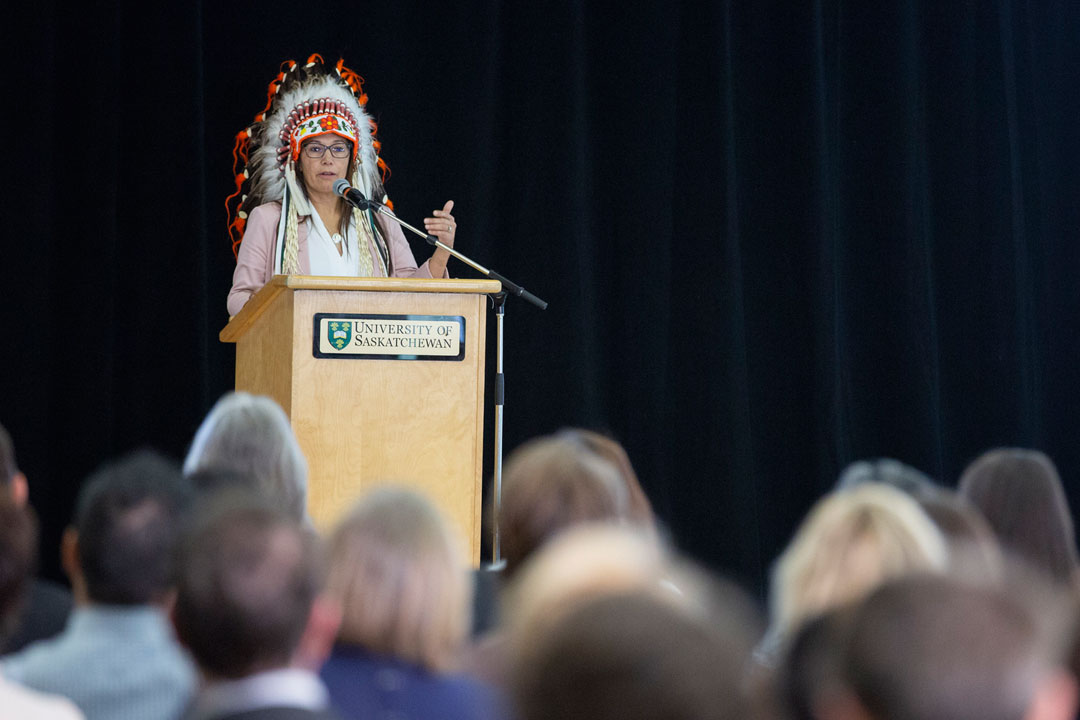
Building Reconciliation Internal Forum another step forward
In a continued commitment to supporting Indigenization and reconciliation on campus and beyond, the University of Saskatchewan brought together students, staff, faculty and Indigenous leaders to take part in its second annual Building Reconciliation Internal Forum.
By HenryTye GlazebrookThe Sept. 18 event, which gathered more than 200 people, was intended as an ideation opportunity through which future and current thought-leaders could share their stories, experiences, and express their aspirations and hopes for Indigenous Peoples, and for all who work and study at the U of S.
“The reason that we gather is to respectfully and constructively engage in dialogue about the aspirations we have for this university and to share with each other the successes that we have experienced along the way,” said Vice-provost Indigenous Engagement Jacqueline Ottmann, who is Anishinaabe (Saulteaux) and a member of Saskatchewan’s Fishing Lake First Nation.
The Building Reconciliation Internal Forum was launched by the U of S in 2017 as a response to the 94 calls to action of the Truth and Reconciliation Commission of Canada. In its second iteration this year, the goal was to take that initial dialogue a step further by inviting attendees to take a larger role in the conversation through smaller interactive, group-focused discussions.
“We have spoken a lot at this university, collectively and individually and independently, about Indigenization and about closing the education gap between Indigenous and non-Indigenous people,” said U of S President and Vice-Chancellor Peter Stoicheff. “It's real, it’s significant, it’s endemic, it’s systemic, it’s historical, and for that reason the discussions that lead to action at this university—at all universities—are particularly crucial to reconciliation in this country.”
Event attendees were split into four groups for the greater part of the day, taking part in two 45-minute long conversation circles in the morning and another two in the afternoon. The circles were structured around discussions of the Indigenous student experience; building and sustaining relations through allyship; Indigenous perspectives on research; and reconciliation through anti-racist, anti-oppression education.
Chief Tammy Cook-Searson of the Lac La Ronge Indian Band emphasized the importance of open and honest discussions about the historical treatment of Indigenous Peoples in Canada, highlighting the stark difference between her own experience as a seven-year-old in residential schools and the efforts being made for reconciliation today.
“I didn’t have my mom or dad to say goodnight, and then my hair was cut off and I was made to feel like I was dirty or not good enough,” Cook-Searson said. “That’s how we were treated all these years as First Nations people, and we’re finally starting to call it what it is. We’re finally starting to have more of a voice. I experienced sexual abuse there, and I never talked about it until just a few years ago. I didn’t want to. I was too ashamed. I thought it was my fault, but it wasn’t.”
Eugene Arcand, a Cree from the Muskeg Lake First Nation in Saskatchewan, spoke to the importance of education in producing true, lasting societal change.
“You have a choice to come here. You have a choice to attend school or work here. You’re not being picked up and taken away—we had no choice,” Arcand said, emphasizing the achievement of leaders in the Indigenous community in helping to found the Indian Teacher Education Program, the Wiyasiwewin Mikiwahp Native Law Centre and other Indigenous-focused institutions at the U of S. “When my own granddaughter graduated here as a nurse, it brought tears to my eyes.”
HenryTye Glazebrook is a former U of S employee and freelancer writer.

